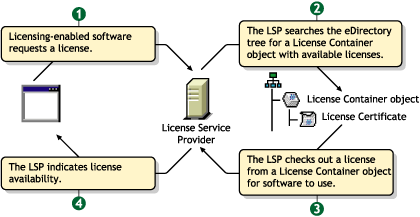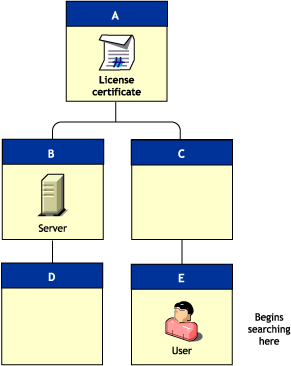1.3 How Novell Licensing Services Works
Novell Licensing Services is comprised of the following components:
-
NLS Clients requests licensing services from license service providers.
-
License Service Provider is software that you install and run on NetWare servers.
-
Nlsrup.nlm gathers network usage information
-
Novell Remote Manager lets you view version information about Novell Licensing Services.
-
Novell iManager lets you install and manage license certificates in an eDirectory tree and monitor NetWare usage.
1.3.1 How Novell Licensing Services Interacts with eDirectory
Figure 1-1 How NLS Works

Corresponding with the above figure, the following sequence outlines how license service providers handle requests from NLS clients by interacting with the eDirectory database.
-
An application issues a request to the NLS client.
In NetWare, for example, the server requests a license unit on behalf of the user that is connecting to the server. The server issues this request to the NLS client.
-
The NLS client library packages the request from the application and submits it to a license service provider.
In NetWare, for example, the NLS client communicates with the license service provider on that server.
-
The license service provider examines the request and determines whether it can fill the request. It does this by checking the eDirectory context of the requesting client for the specific information or license unit being requested.
In NetWare, for example, the license service provider searches the user’s context for a NetWare license unit.
-
If the requested resource is available, the license service provider fills the request. If the license service provider cannot fill the request, it searches for a resource. Where an license service provider starts its search for a resource depends on what the requesting application has specified.
The license service provider can check the next-higher context in eDirectory for the requested resources. The license service provider continues to search until it reaches the [Root] or Tree of the partition or the top of the tree, depending on how the license service provider is configured.
In NetWare, for example, the license service provider starts in the user’s context and searches up the eDirectory tree for a user license.
The following figure illustrates how an license service provider searches for a license certificate in the User Access Licensing model.
Figure 1-2 How the license service provider searches for a license

In this example, the user accesses the network from context .E.C.A. To search for a license unit, the license service provider begins its search in the user’s context—.E.C.A The license service provider searches up the tree to context A and finds an available license unit.
-
The license service provider returns status to the client library.
In NetWare, for example, if the license service provider finds a NetWare license unit, it returns a successful status to the library. Otherwise, it returns an error code.
-
The library returns status to the application.
In NetWare, for example, the library returns licensing status to the server.
-
The application determines action based upon the status of license units.
In NetWare, for example, the server determines an action. If the status is successful, the server allows a connection to the server. Otherwise, the server allows a grace connection if one is available, or denies service if a grace connection isn’t available. Up to 3 grace connections are allowed.
1.3.2 Example of NLS Client Software on a Client Workstation
At your Windows* 2000 workstation you want to use OptionsPlus, an NLS-enabled application. After you click the icon for OptionsPlus, that application loads on your client workstation.
OptionsPlus then requests a license unit. The NLS component (a .dll file linked to OptionsPlus software) locates a license service provider (an NLS component running on a server). That license service provider searches eDirectory for a License Certificate object that has license units available.
The license service provider responds to the NLS client in OptionsPlus and allows you to use the application.
1.3.3 Example of NLS Client Software on a Server
When starting a server, NetWare loads and runs eDirectory and a license service provider, two necessary components of the NLS system.
Before completing its booting up, NetWare’s policy manager uses NLS client software (an NLM™ library for NLS) to request a server base license from the license service provider.
The license service provider then queries eDirectory for a license certificate. If a license unit is available, the license service provider then grants the request for the policy manager, and the NetWare server is allowed to run.
NLS itself does not enforce licensing. Instead, it checks out a license unit or returns the appropriate error condition to the application. The policy manager part of the application then determines whether the user can use the application and how the error condition is reported.
1.3.4 Example of Metering
A client workstation requests an application that is not NLS-enabled. ZENworks, integrated with NLS, requests a license unit on behalf of the application.
Depending on the response from NLS, Application Launcher in ZENworks chooses whether to load the application. Therefore, Application Launcher can be configured to request license units for applications that are not NLS-aware.